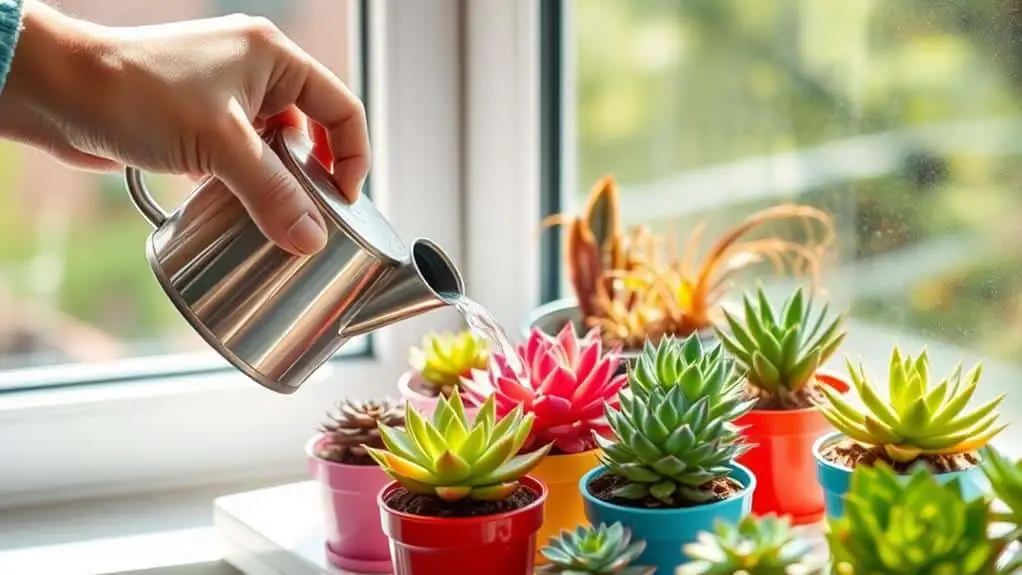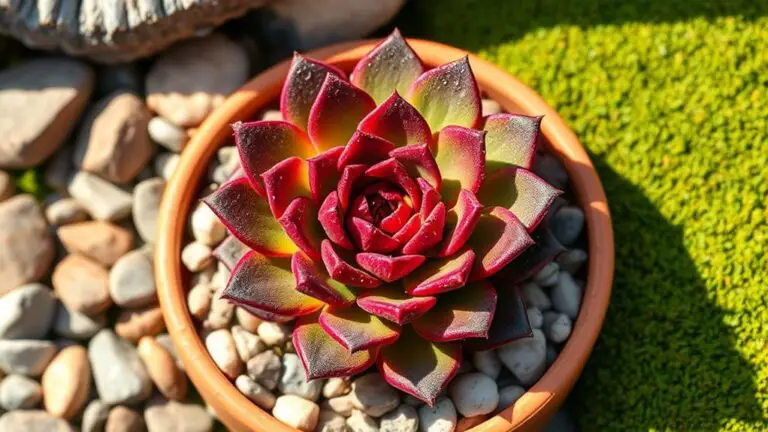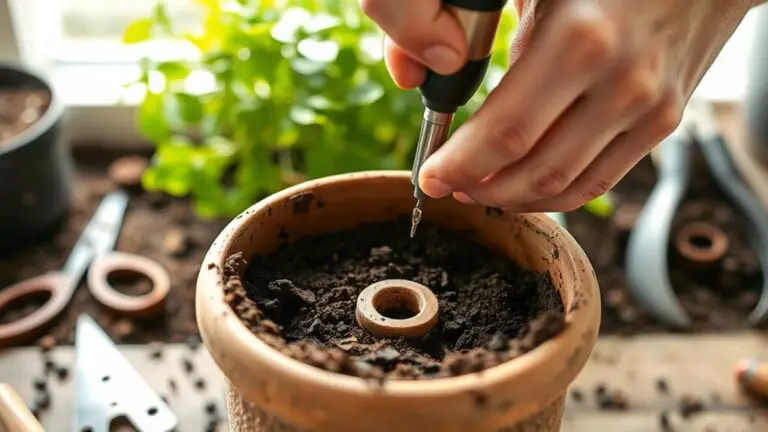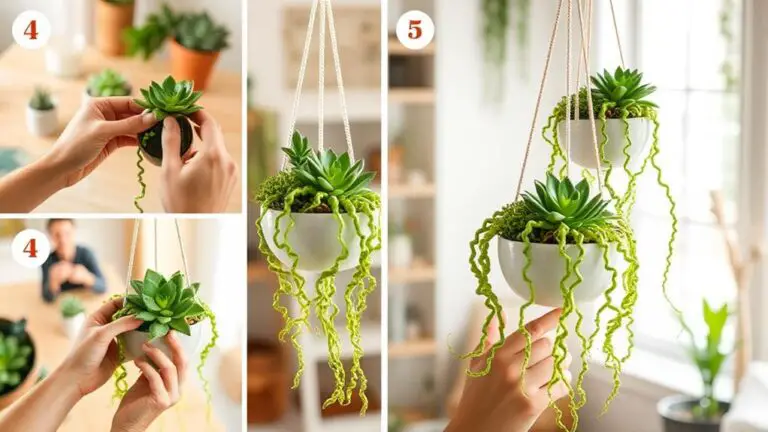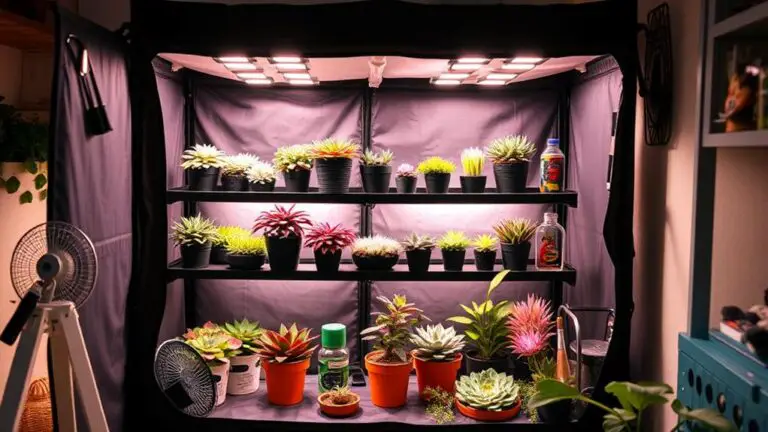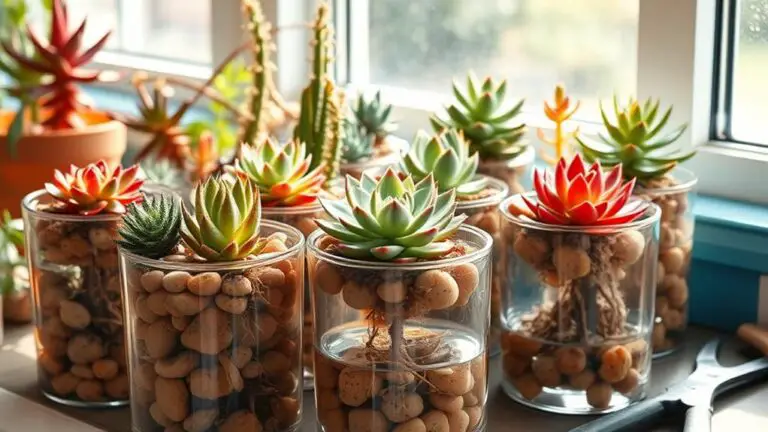10 Steps to Perfectly Watering Your Succulent Plants
You've likely heard that succulents are low-maintenance, but getting their watering just right can be tricky. To guarantee your plants thrive, you need to follow a precise approach, starting with understanding their unique requirements. Using well-draining soil and monitoring moisture levels are key steps. But there's more to it—timing, frequency, and even the season play important roles. So, how do you master the art of watering succulents? Let's break it down into ten essential steps that will transform your plant care routine.
Check Soil Moisture
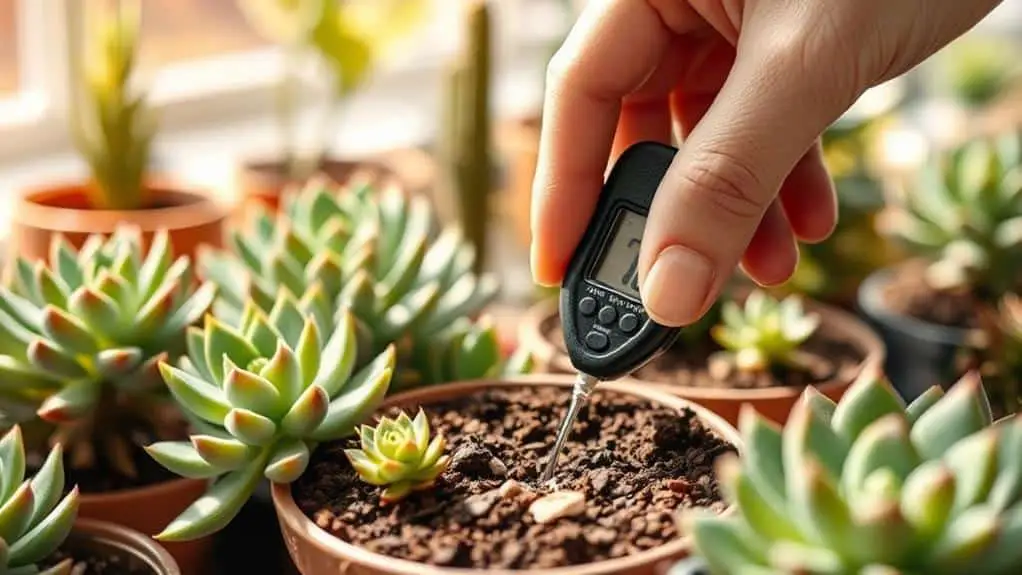
To guarantee your succulent thrives, checking the soil moisture is essential. Start by inserting your finger about 2 inches deep into the soil. If it feels dry and crumbly, it's time to water. This simple step guarantees you're not overwatering or underwatering your plant.
For more accuracy, use a moisture meter. This handy tool gives you precise readings of the soil's moisture content, helping you decide when it's time for watering succulents. You'll find it especially useful if you're just starting out or if you have many plants to care for.
Another method is to observe the weight of the pot. A lighter pot typically means the soil has dried out sufficiently, while a heavier one suggests retained moisture. This can be a quick way to check the soil without digging in.
Look for visual signs of moisture stress, like wrinkled leaves. These are clear indicators that your succulent needs water.
Use the Soak and Dry Method

The Soak and Dry Method is a great way to keep your succulents healthy and happy.
Start by watering your plants thoroughly until water drains out of the bottom of the pot.
Then, wait for the soil to dry completely before watering again, checking the moisture by sticking your finger about two inches into the soil.
Water Until Drainage Occurs
A crucial step in maintaining healthy succulents is to water until you see drainage, employing the Soak and Dry Method. This method guarantees that your succulents get the deep watering they need. To start, you'll want to water your succulent thoroughly. Keep going until water drains out of the bottom of the pot. This way, the entire root system receives adequate hydration, which is important for the plant's health.
Succulents need their soil to dry out completely between waterings. After you've soaked the soil, let it dry out. This can take anywhere from 1 to 3 weeks depending on your environment. Using a moisture meter can help you monitor the soil's moisture level effectively. Alternatively, you can check the soil with your finger.
Avoid shallow watering. It only wets the top layer of soil and doesn't promote strong root growth. Deep watering the succulent with the soak and dry method encourages robust roots and helps the plant become more drought-resistant.
Check Soil Before Watering
Regularly checking the soil before watering your succulents is vital for their health. You should always check the soil moisture level by inserting your finger into the soil. If it feels dry several inches down, it's time to water your succulent. This guarantees that the roots receive adequate hydration without being overwatered.
Utilize the soak and dry method by thoroughly watering the plant until excess water drains from the bottom. This helps guarantee the roots are well-hydrated. Allowing the soil to dry out completely between waterings is essential, as succulents thrive in a dry environment. This helps prevent root rot and other moisture-related issues.
Don't follow a fixed schedule for watering. Instead, assess the soil moisture and consider environmental conditions like temperature and humidity, which can greatly affect watering frequency. A moisture meter can be a helpful tool to accurately gauge soil dryness.
Here's a quick reference table:
| Action | What to Do | Why It's Important |
|---|---|---|
| Check Soil | Insert finger into soil | Assess dryness before watering |
| Water When Dry | Water until excess drains out | Guarantee roots get adequate water |
| Allow Soil to Dry | Wait until completely dry | Prevent root rot |
| Use Moisture Meter | Measure soil dryness | Accurate watering timing |
| Adjust Watering Frequency | Consider temperature and humidity | Adapt to changing conditions |
Ensure Soil Dries Completely**
Ensuring your succulent's soil dries completely before the next watering is essential to prevent root rot and other moisture-related issues.
To start, always check a few inches deep into the soil. It should feel crumbly and loose, indicating it's fully dry.
The "Soak and Dry" method is perfect for this. When you water, thoroughly soak the soil until you see water draining from the bottom of the pot. This deep watering encourages strong root growth, helping your succulent withstand drought conditions better.
After soaking, let the soil dry out entirely before watering again. This prevents overwatering and the excess moisture that can cause root rot.
To be sure you're not watering too soon, wait until the soil feels dry and light. This is key because succulents are very sensitive to overwatering.
Regularly check your succulents for signs of dehydration, like wrinkled leaves, to create a watering schedule that fits their needs.
Ensure Proper Drainage
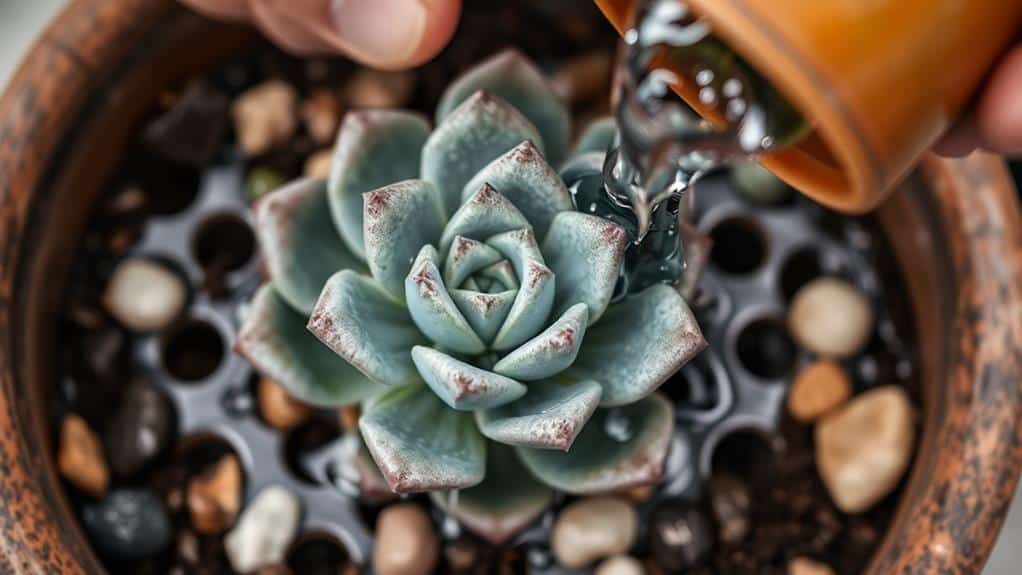
To keep your succulent plants thriving, proper drainage is essential. First, make sure every pot has a drain hole. These drainage holes let excess water escape, preventing water from accumulating and causing root rot.
Using the right potting soil is also vital; choose mixes made for succulents. These mixes contain more inorganic materials, which help with rapid drainage and promote airflow.
Next, consider using terra cotta pots. Terra cotta wicks moisture away from the soil and improves air circulation, keeping your succulent's roots dry.
If you prefer decorative containers that don't have drainage holes, place your succulent in a smaller pot with drainage inside the decorative one. This way, you can still enjoy the look without sacrificing proper drainage.
Additionally, regularly check the weight of your containers. Lighter pots usually mean the soil is dry, while heavier pots might indicate excess moisture. This simple check helps you know when to water your succulents, ensuring you don't overwater them.
Water at the Right Time
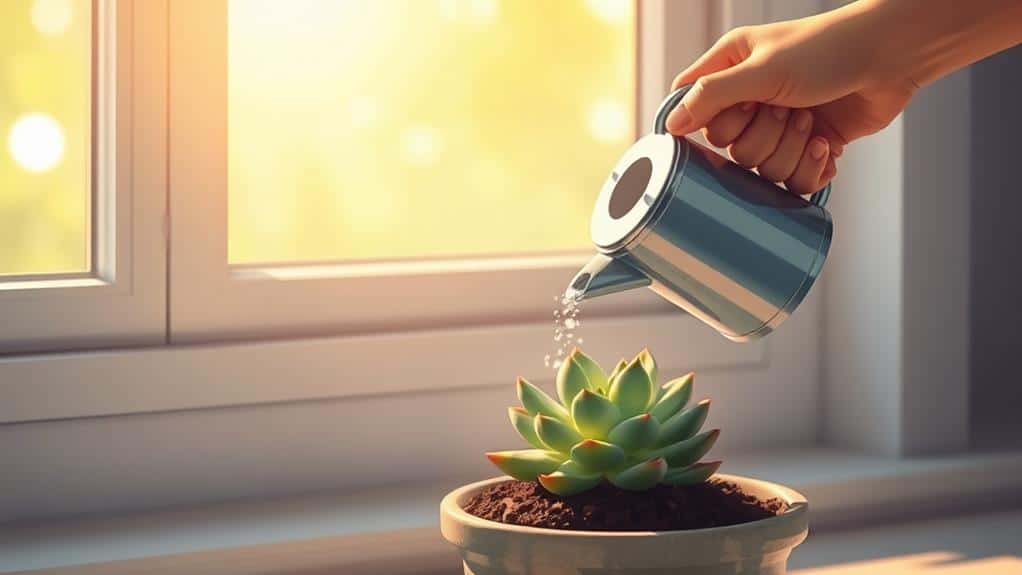
Timing is essential when it comes to watering succulents. To keep your plants thriving, you need to water your succulents only when the soil is completely dry. A good rule of thumb is to check them every 1-3 weeks, but this can vary based on environmental factors and the season.
The best time to water your succulents is early in the morning. This allows any excess moisture to evaporate throughout the day, reducing the risk of leaf rot. During hotter months, you might find that your succulents need to be watered more frequently. In contrast, during winter, you can usually reduce watering to about once a month.
To guarantee you're watering at the right time, monitor soil moisture regularly. Use the finger test or a moisture meter to check the top couple of inches of soil. If it feels dry, it's time to water.
Here's a quick reference table to help you remember:
| Environmental Condition | Frequency for Watering | Best Time to Water |
|---|---|---|
| Hotter Months | Every 1-2 weeks | Early in the morning |
| Cooler Months | Once a month | Early in the morning |
| General Rule | When soil is dry | Early in the morning |
Monitor Seasonal Changes

Why is it important to monitor seasonal changes when caring for succulents? Well, succulents have different needs depending on the time of year. In spring and summer, you'll notice they require more frequent watering, perhaps every 1-2 weeks. This is because they're growing more and temperatures are warmer, which increases their water consumption.
As winter approaches, many succulents enter a dormant phase. During this time, their water absorption slows down, and they may only need watering once a month or even less. It's vital to adjust your watering frequency to avoid over and under-watering, which can affect succulent health.
Humidity levels also play a role. Higher humidity means you mightn't need to water as often, while dry conditions may require more frequent checks. Seasonal temperature changes can cause soil to dry out faster, so regularly monitoring soil moisture is important.
Look for signs of distress like wilting or color changes during these changes. These clues can help you adjust your watering schedule effectively.
Understand Your Succulent Species

To care for your succulents properly, you need to know what species you have.
Different types have unique needs for water, light, and heat.
For example, agaves need less frequent watering than jade plants, so identifying your succulent helps you meet its specific requirements.
Species Watering Frequency
Understanding your succulent species' watering frequency is essential for their health and growth. Different succulent species have varying needs, and knowing the right watering schedule is key. For instance, Echeveria and Sedum typically need watering every 1-2 weeks during the growing season.
On the other hand, Aloe can often go for 2-3 weeks between waterings. You should also consider environmental factors like humidity and temperature. Higher temperatures can cause the soil to dry out faster, meaning you might need to water certain species more often.
Always water when the soil is completely dry to maintain a healthy root system. Cacti, which are a type of succulent, require more frequent watering in the summer but need less during winter, sometimes as infrequently as once a month.
Monitoring your succulent's health cues, such as leaf firmness and color, helps you adjust the watering frequency to keep your plants thriving. Understanding species watering frequency helps you cater to each plant's unique needs, ensuring they stay happy and healthy.
With a bit of observation and care, you'll develop a schedule that suits each succulent perfectly.
Storage Capacity
Beyond understanding how often to water your succulents, it's important to know how much water they can store. Succulents are unique because they store water in their leaves, stems, or roots. This ability helps them survive in arid environments, but it also means they've different watering needs.
With over 10,000 species of succulents, each has its own storage capacity. For instance, larger succulents like agaves can hold more water than smaller ones like sedums. This difference affects how often and how much you should water them. Knowing your succulent's specific needs can prevent overwatering, which can lead to root rot, or underwatering, which can cause dehydration.
For example, Aloe vera can handle more moisture compared to some cacti, which are very sensitive to overwatering. It's essential to understand the storage capacity of your succulent species.
Check the leaves and soil to gauge if they need more or less water. If the leaves are plump and firm, the plant is well-hydrated. If they're shriveled, it might be time to water.
Tailoring your watering schedule to fit your succulent's storage capacity helps keep them healthy and thriving.
Light and Heat Needs**
Caring for your succulents involves more than just watering; their light and heat needs are equally vital. Different succulent species have varying light requirements. Some thrive in bright, indirect sunlight, while others need several hours of direct sun each day. Understanding your succulent's specific light preference can help you position them correctly in your home or garden.
Temperature is another essential factor for succulent health. Most varieties enjoy temperatures between 60°F to 80°F (15°C to 27°C). If you live in a region with high heat, remember that direct sunlight can cause the soil to dry out faster, which means you'll need to water more often, especially during the growing season in spring and summer.
Be mindful of cold temperatures, too. Many succulents can't handle temperatures below 50°F (10°C). If it gets too chilly, bring them indoors to keep them safe.
Watch out for signs of too much or too little light, like stretching towards the light, which can make them weak and leggy.
Avoid Overwatering
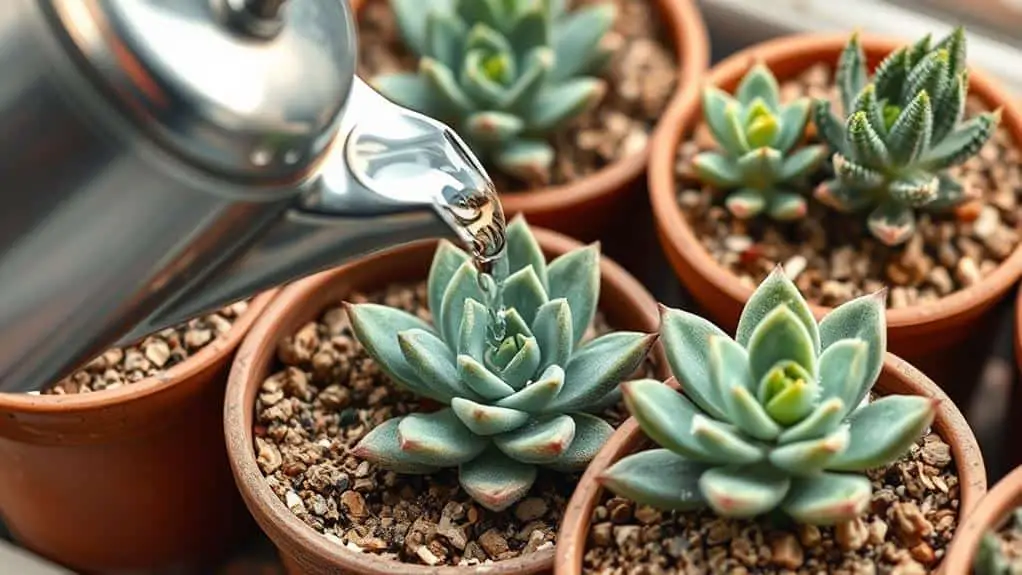
Although succulents are renowned for their drought tolerance, overwatering can quickly lead to their demise. Succulents thrive in conditions where they can dry out between waterings.
Too much water can cause root rot due to excess moisture retention in the soil. To avoid overwatering, follow these essential tips:
- Confirm your pots have adequate drainage holes. This allows excess water to escape, preventing water accumulation.
- Use a well-draining soil mix specifically designed for succulents. This type of soil contains a balance of inorganic materials that facilitate rapid drainage.
- Allow the soil to dry completely between waterings. The "soak and dry" method works best, where you water thoroughly and then let the soil dry out entirely before the next watering.
- Regularly monitor your soil's moisture levels. You can use the finger test or a moisture meter to determine if the top few inches of soil are dry enough to water again.
- Avoid watering too frequently. Succulents store water in their leaves and stems, so they don't need to be watered as often as other plants.
Watch for Signs of Underwatering

Just as overwatering poses a significant threat to succulents, underwatering can also lead to serious issues. When your plants don't get enough water, they show specific signs that you need to watch for. One of the first indicators is wrinkled leaves. If you notice the leaves looking shriveled and dehydrated, it's a clear sign they need water.
Another sign of underwatering is bendy leaves that lack firmness. Healthy succulent leaves should be plump and rigid. If they start to feel soft and limp, your plant is definitely crying out for moisture.
Also, check for crispy leaf edges. When the edges of the leaves turn dry and brittle, it means your plant isn't getting sufficient moisture.
Size shrinkage, especially in cacti, is another major indicator of dehydration. If you notice your cactus getting smaller, it's time to water it.
Finally, always check the soil. Dry soil is a clear sign of underwatering. Make it a habit to feel the soil to confirm the plant's needs.
Caring for succulents involves finding the right balance of water. By keeping an eye on these signs, you can guarantee your plants stay healthy and vibrant.
Track Your Watering Schedule

Maintaining a detailed watering schedule is essential for the health of your succulents. To track your watering schedule, you can use various tools like spreadsheets, mobile apps, or even simple pen and paper. Keeping a record of watering dates helps you establish a consistent routine, preventing both overwatering and underwatering.
Visual documentation of your plants' health is also beneficial. By noting any changes in appearance, you can recognize patterns and adjust your care as needed. This practice keeps your succulents thriving.
To make tracking easier, try these tips:
- Use a spreadsheet: Create columns for watering dates, plant health notes, and reminders.
- Mobile apps: Download a plant care app that can send you reminders when it's time to water.
- Pen and paper: Keep a journal with a section dedicated to watering history.
- Cheat sheet: Make a quick reference guide for signs of overwatering and underwatering.
- Photos: Take pictures of your plants regularly to monitor any changes over time.
Adjust for Environmental Factors
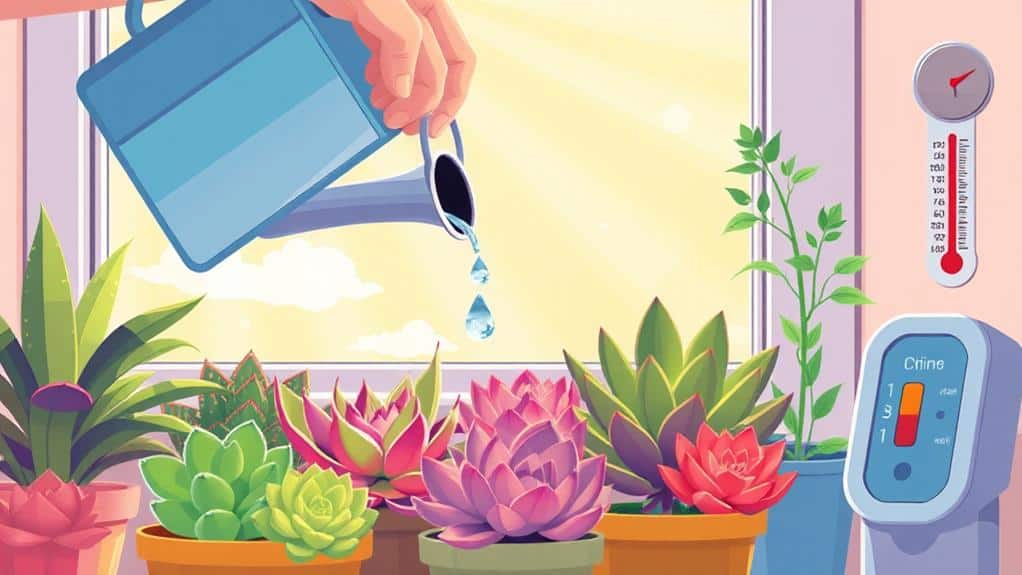
Tracking your watering schedule is a great start, but it's also important to adjust for environmental factors to keep your succulents healthy.
First, monitor temperature changes. Higher temperatures make soil dry out faster, so you'll need to water more often. In contrast, in humid environments, reduce your watering frequency. High moisture levels in the air mean the soil dries out slower, which can lead to overwatering.
Next, consider the container size. Larger pots hold moisture longer and might need less frequent watering than smaller pots.
Also, adjust your watering schedule based on the seasons. During the growing months of spring and summer, increase your watering frequency. In winter, when succulents go dormant, water them only once a month.
Light exposure is another critical factor. The more light your succulents receive, the more water they'll need. If they're in lower light conditions, you can water them less often.
Frequently Asked Questions
How to Water Succulents Properly?
To water succulents properly, use the soak and dry method. Water thoroughly, then let the soil dry completely before watering again. Check soil moisture regularly, guarantee pots have drainage holes, and avoid wetting the leaves.
Should I Water My Succulents From the Top or Bottom?
You should water your succulents from the bottom. This method prevents moisture on the leaves, reduces the risk of rot, and promotes strong root growth. Confirm your pot has drainage holes to avoid waterlogging and root rot.
Should I Spray My Succulents With Water?
You shouldn't spray your succulents with water. Instead, water them directly at the soil level. Spraying can cause rot and fungal issues, especially in humid environments. Only mist sparingly if propagating in extremely dry conditions.
Is Tap Water Ok for Succulents?
Tap water's generally okay for succulents, but it may contain harmful chemicals. Let it sit for 24 hours to dissipate chlorine. If you notice issues like leaf spots, switch to distilled or filtered water for better results.
Conclusion
You've got all the tips you need to water your succulents perfectly! Remember to check the soil moisture, use the soak and dry method, and guarantee proper drainage. Keep an eye on seasonal changes and adjust your watering schedule accordingly. Don't forget to watch for signs of overwatering or underwatering. With these steps, you'll keep your succulents happy and healthy. Trust yourself and enjoy the process—your plants are in good hands!

